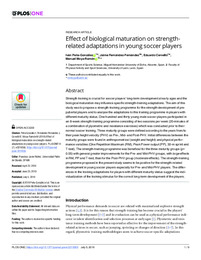Please use this identifier to cite or link to this item:
https://hdl.handle.net/11000/35227Full metadata record
| DC Field | Value | Language |
|---|---|---|
| dc.contributor.author | Peña-González, Iván | - |
| dc.contributor.author | Fernández-Fernandez, Jaime | - |
| dc.contributor.author | Cervelló, Eduardo | - |
| dc.contributor.author | MOYA-RAMÓN, MANUEL | - |
| dc.contributor.other | Departamentos de la UMH::Ciencias del Deporte | es_ES |
| dc.date.accessioned | 2025-01-24T11:41:02Z | - |
| dc.date.available | 2025-01-24T11:41:02Z | - |
| dc.date.created | 2019 | - |
| dc.identifier.citation | PLoS ONE | es_ES |
| dc.identifier.issn | 1932-6203 | - |
| dc.identifier.uri | https://hdl.handle.net/11000/35227 | - |
| dc.description.abstract | Strength training is crucial for soccer players’ long-term development at early ages and the biological maturation may influence specific strength-training adaptations. The aim of this study was to propose a strength-training programme for the strength development of pre-pubertal players and to analyse the adaptations to this training programme in players with different maturity status. One hundred and thirty young male soccer players participated in an 8-week strength-training programme consisting of two sessions per week (20-minutes of a combination of plyometric and resistance exercises) which was conducted prior to their normal soccer training. Three maturity groups were defined according to the years from/to their peak height velocity (PHV) as Pre-, Mid- and Post-PHV. Initial differences between the maturity groups were found in anthropometrical (weight and height) and physical performance variables (One Repetition Maximum (RM), Peak Power output (PP), 30-m sprint and T-test). The strength-training programme was beneficial for the three maturity groups (p< 0.05) with general greater improvements for the Pre- and Mid-PHV groups, with large effects in RM, PP and T-test, than for the Post-PHV group (moderate effects). The strength-training programme proposed in the present study seems to be positive for the strength-related development in young soccer players especially for Pre- and Mid-PHV players. The differences in the training adaptations for players with different maturity status suggest the individualization of the training stimulus for the correct long-term development of the players. | es_ES |
| dc.format | application/pdf | es_ES |
| dc.format.extent | 9 | es_ES |
| dc.language.iso | eng | es_ES |
| dc.publisher | Public Library of Science | es_ES |
| dc.relation.ispartofseries | 14 | es_ES |
| dc.relation.ispartofseries | 7 | es_ES |
| dc.rights | info:eu-repo/semantics/openAccess | es_ES |
| dc.rights.uri | http://creativecommons.org/licenses/by-nc-nd/4.0/ | * |
| dc.subject.other | CDU::7 - Bellas artes::79 - Diversiones. Espectáculos. Cine. Teatro. Danza. Juegos.Deportes | es_ES |
| dc.title | Effect of biological maturation on strength-related adaptations in young soccer players | es_ES |
| dc.type | info:eu-repo/semantics/article | es_ES |
| dc.relation.publisherversion | https://doi.org/10.1371/journal.pone.0219355 | es_ES |

View/Open:
2019 (Q2) [PlosOne] Effect of biological maturation on strengthrelated adaptations in young soccer players.pdf
507,49 kB
Adobe PDF
Share:
.png)
